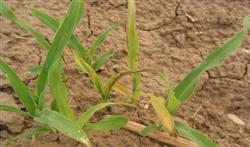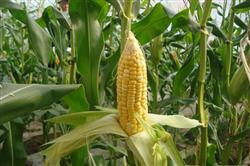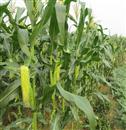Corn planting techniques: what is maize seedling blight?

What is corn seedling blight? How to control corn seedling blight? Please give an introduction and its control methods. The harm and control of maize seedling blight have been sorted out by the planting network for netizens' reference. Harm of maize seedling blight: maize seedling blight mainly occurs in maize seedling stage. The susceptible plant first browns from one, several or tip of the seed root, and then expands into a segment or whole root system, one or more of which can occur at the same time, and then infect the roots (mesoradicals), resulting in root dysplasia, reduction of root hairs, no secondary roots or a small number of secondary roots, aging of primary roots, cortical necrosis, dark brown roots, and necrotic ring spots at the first Internode; water stains rot at the base of the stem. The basal internodes are easy to break neatly under the action of external force; the upper leaf sheath of corn is brown tearing, the leaves are yellow, the edges are scorched, the heart leaves are curled and easy to break, and then the leaves gradually dry up from bottom to top; dead seedlings without secondary roots, weak seedlings with a small amount of secondary roots, and white mildew in the parts of the dead seedlings near the ground when the humidity is high. There are no obvious symptoms in the aboveground parts with mild harm. generally, the leaf tips of the first and second leaves appear yellowing at the first and second leaf stage, and gradually develop to the middle of the leaf. After the aboveground stem node director gives off air and takes root, the absorptive capacity is enhanced and can continue to grow into a key plant, but the seriously harmful plant leaves appear fire-like death, the heart leaves gradually wither and wilt, and the base of the stem rotates, which can be pulled up gently with the hand. Causes of maize seedling blight: 1. Climatic conditions: maize seedling blight generally occurs from early June to early July. The climatic conditions affecting maize seedling blight are mainly temperature and humidity, and long-term "low temperature and high humidity" is beneficial to its occurrence. According to the investigation, during the period from sowing to rooting, maize suddenly encountered heavy rain and caused soil hardening, resulting in an environment of low soil temperature and high humidity. It is easy to be infected with this disease, while the land sown after rain of the same variety is basically not affected, indicating that the degree of disease has a lot to do with climatic conditions. 2. Variety causes: according to the investigation from 1998 to 2002, although the maize varieties such as Ludan 50, Nongda 108 and Ludan 981 had strong disease resistance in the middle and later growth stage, their growth potential was weak at seedling stage, and their roots were very susceptible to seedling blight. The expansion of variety area with 178 or Qi 319 inbred lines as parents is the main reason for the large occurrence area of seedling blight in recent years. 3. Soil and management measures: low-lying land, poor soil, sticky land, saline-alkali land and the application of corn herbicides. In addition, the disease is easy to occur when sowing too deep. 4. Rotation: wheat / corn is the main rotation mode in our province. Wheat root disease occurred seriously in recent years, which led to the accumulation of pathogens such as Fusarium moniliforme, Fusarium graminearum and Rhizoctonia, and aggravated the occurrence of maize seedling blight. Corn seedling blight control methods: 1. Rational fertilization, strengthen field management: rational fertilization is an important measure to reduce seedling blight, sowing should be suitable to apply base fertilizer, increase phosphorus fertilizer, cultivate strong seedlings; ploughing corn in time after emergence or rain, in order to facilitate root ventilation and promote root growth. 2. Seed dressing and disease prevention: 50% carbendazim wettable powder can be used to mix seeds according to 0.2%-0.3% of the seed amount. 20% of Huayang's corn special seed coating agent or coated seeds can kill insects and strengthen seedlings, and get more with one stone. In addition, in the past two years, 25% of the new seed coating agent was mixed with 0.2% of seed, and the control effect was more than 90%. 3. When the seedling blight is found at the seedling stage, methyl-phosphos can be used to control the disease. Generally, strong roots can be grown after 3 days of spraying. You can also choose one of the following pesticides to spray on the base: 50% carbendazim, 20% triadimefon, 3000 times, corn, 1000 times, twice in a row. Click to get more corn planting techniques click to get more food crop planting techniques
- Prev

Corn planting techniques: what are the methods of promoting summer corn ripening?
What are the methods to promote the ripening of summer corn? Please introduce that the ripening promotion of summer corn can be carried out by the following methods: 1. Peeling the bracts and drying the ears: when the corn begins to harden in the middle stage of wax ripening, the bracts of the corn are gently peeled off one by one, so that all the grains are exposed and let the sun shine directly. In general, peeling and drying for 15-20.
- Next

Corn planting technology: how to manage in the later stage of planting summer corn?
How to manage in the later stage of planting summer corn? Please introduce the management methods for the later stage management of planting summer corn can refer to the following methods: 1. Ensure moisture during the corn filling period: the rainy season in the later period of corn growth has basically passed, if drought directly affects corn filling, we must overcome the paralysis thought of relying on the weather and other rain. Grouting water.
Related
- The first cup of black tea in spring, the flavor and history of tea gardens in Kenya, Africa
- The computer can not only choose potatoes, but also grow tea rice. AI will grow winter oolong tea champion.
- It is not only the inflated tea bitten by insects, but also engraved with the four seasons tea in Beipu.
- The Oriental Beauty Tea Festival in Zhuxian County takes the stage at the weekend to experience the plus-size feast of oil tea.
- & quot; Oriental Beauty Tea & Exploration of Emei in Hsinchu, the hometown of quot;
- The new variety of strawberry "Tainong 1" dessert is the first choice with mellow aroma. Crimson gorgeous
- History of Tea in Taiwan: from Wild Inner Mountain to Export Tea Garden
- Two types of Taiwan Oriental Beauty Black Tea won the British three-Star Award for Childhood Tea Xiang Zhang Jiaqi changed from pilot to champion tea maker.
- Banana species and varieties: the planting history of Taiwan Xianren banana and dwarf banana is long, is banana disease resistant?
- Coffee planting Technology: Qianjie Coffee from Seedling to harvesting

